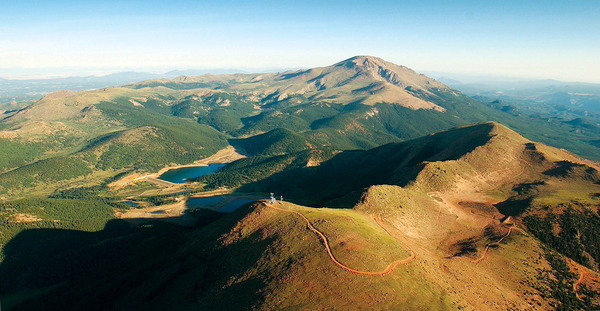The Local newsletter is your free, daily guide to life in Colorado. For locals, by locals.
 A few stubborn leaves cling to aspen branches along the Mason Trail 20 miles east of Cripple Creek as I skirt a soggy wetland patch and climb toward an open meadow. Here, sepia-tone willows poke through six inches of snow; on the horizon, the rugged summit of Pikes Peak stands majestic behind a veil of clouds. Just over a mile from the South Slope Trailhead, where I’d started, I crest a ridge and discover a pair of jubilant fly fishermen shouting at the edges of the argentine Mason Reservoir. “Another one!” they yell, hauling in what must be at least their 10th cutthroat trout of the day. But it’s not a fair fight: The fish of Pikes Peak’s South Slope haven’t known a hook in more than a hundred years.
A few stubborn leaves cling to aspen branches along the Mason Trail 20 miles east of Cripple Creek as I skirt a soggy wetland patch and climb toward an open meadow. Here, sepia-tone willows poke through six inches of snow; on the horizon, the rugged summit of Pikes Peak stands majestic behind a veil of clouds. Just over a mile from the South Slope Trailhead, where I’d started, I crest a ridge and discover a pair of jubilant fly fishermen shouting at the edges of the argentine Mason Reservoir. “Another one!” they yell, hauling in what must be at least their 10th cutthroat trout of the day. But it’s not a fair fight: The fish of Pikes Peak’s South Slope haven’t known a hook in more than a hundred years.
The last time the South Slope trails were open to the public, Model T’s had started to replace horse-drawn carriages on Denver streets, and the new neighborhoods of Park Hill and Washington Park marked the edges of the city. In those days, adventurous tourists rode burros up Pikes Peak—crossing through this very area in woolen suits and billowing dresses to marvel at the expansive mountainscape. But in 1913 the federal government deeded the seven lakes and reservoirs of the South Slope to Colorado Springs for watershed protection, and the city closed the area to protect its first mountain water supply system. The city kept those 9,000 acres locked away—until now.
After decades of lobbying by outdoor enthusiasts—and seven years of joint planning with recreation and environmental groups to balance usage—this month, the city is reopening the Pikes Peak South Slope Recreation Area to fishing, hiking, mountain biking, and eventually horseback riding. Of course, it’s not a free-for-all. The city will grant only 16 vehicle permits per day—no walk-ins—to protect the reservoirs that still supply water to Colorado Springs, as well as the subalpine forest and wetlands at about 11,000 feet that bighorn sheep and white-tailed ptarmigan call home. When I landed a preview permit last fall, I’d hoped to see some of that wildlife on the 9.4-mile round-trip hike to Boehmer Reservoir. Built in 1894, Boehmer is the oldest man-made reservoir in the South Slope Water System and lies like a mirror directly below Pikes Peak. (It’s also as far as you can go right now; more trail development is planned for the future, though a path to the summit is not being considered.)
But back at Mason Reservoir, watching the wind whip the waters into tiny whitecaps, I worry Mother Nature might have a different plan. As the anglers reel in their lines and prepare to leave, I depart the lakeshore and continue up the trail. Not a single track mars the snow. I chuckle at the thought of the mountain bike in my truck at the trailhead. I’d hoped to sneak in some single-track; I should have brought snowshoes instead.
A little farther up the trail, the forest of stately Engelmann spruce thickens. Quarter-size snowflakes pile up on my jacket as my boots plunge through snow and ice; I’m postholing up to my knees. At this pace, I won’t make it to Boehmer Reservoir and back to the gates before the park ranger closes them at 2:30 p.m. I look at the untracked powder in front of me, then back at my boot prints, already filling with snow. The ancient spruces creak with the wind. I’ve explored every other side of this iconic mountain, whose summit is reachable by car, train, bike, and foot, and other adventurers are always nearby. Here, it’s just me, the trees, and the unseen wildlife hunkered down for an early blast of winter. I survey the muted scenery again, breathe in the scent of snow and evergreen, and watch my deep exhale add its own tiny cloud to the air. Then I turn around and head for home.









